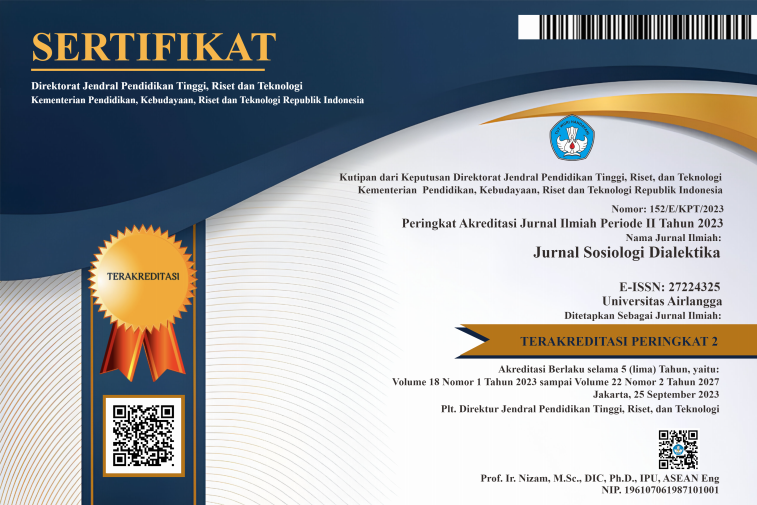The role of Women and Children Protection Technical Implementation Units in alleviating child abuses during the Covid-19 pandemic
Downloads
Child protection is the most important part of protecting the nation's generation from the dangers of crime in society. It is happened due to the fact that childhood is vulnerable to violence and abuse. Children's behavior and life have changed as a result of the Covid-19 pandemic. The current study aims to analyze the scope of duties and functions of UPT PPA (the Women and Children Protection Technical Implementation Units) in alleviating the child abuse cases in Yogyakarta, especially during the Covid-19 Pandemic. The current study employed a qualitative method. The data were collected by observation from the related parties and interviews. This study resulted in the findings that UPT PPA Yogyakarta City assisted in the recovery process for victims of violence through early prevention of violence, assistance, and social reintegration. This study concludes that the efforts made by the UPT PPA of Yogyakarta City have helped to increase family resilience after the occurrence of violence.
Achir YA (1999). Pembangunan Kesejahteraan Keluarga: Sebagai Wahana Pembangunan Bangsa. Jakarta: LP3ES.
Bappeda DIY (2020) Laporan KTPA DIY 2020. Yogyakarta: Bappeda.
Bennell C, Alison LJ, Stein KL, Alison EK, Canter DV (2001) Sexual offenses against children as the abusive exploitation of conventional adult-child relationships. Journal of Social and Personal Relationships 18 (2):155-171. https://doi.org/10.1177/0265407501182001.
Biddle BJ (1986) Recent developments in role theory. Annual Reviews 12 (1):67-92. https://doi.org/10.1146/annurev.so.12.080186.000435.
Bradbury-Jones C & Isham L (2020) The pandemic paradox: The consequences of COVID-19 on domestic violence. Journal of Clinical Nursing 29 (13-14):2047-2049. https://doi.org/10.1111/jocn.15296
Defrain J, Swanson D, Friesen & Brand G (2008) Creating a strong family: Looking at life from a family strength perspective. Neb Guide. [Accessed 11 February 2021]. https://extensionpublications.unl.edu/assets/pdf/g1883.pdf.
Gil DG (2015) Violence against children. The Journal of Pediatrics 79 (5):873. https://doi.org/10.1016/S0022-3476(71)80409-2.
Guedes A, Bott S, Garcia-Moreno C, & Colombini M (2016) Bridging the gaps: a global review of intersections of violence against women and violence against children. Global Health Action 9 (1):1-15. https://doi.org/10.3402/gha.v9.31516.
Gultom M (2013) Perlindungan Hukum terhadap Anak dan Perempuan. Jakarta: Refika Aditama.
Harianti E (2014) Faktor-faktor penyebab terjadinya kekerasan orang tua terhadap anak. Jurnal Ilmu Pemerintahan dan Sosial Politik 2 (1):53-54.
Haryanti SD (2019) Peran pusat pelayanan terpadu perlindungan perempuan dan anak dalam perlindungan kekerasan pada anak di Kabupaten Banjarnegara. Thesis, Universitas Negeri Semarang, Semarang.
Hillis SD, Mercy JA, & Saul JR (2016) The enduring impact of violence against children. Psychology Health & Medicine 1-13. https://doi.org/10.1080/13548506.2016.1153679.
Kholiq A (2018) Analisis pelaksanaan peranan Pusat Pelayanan Terpadu Pemberdayaan Perempuan Dan Anak dalam meningkatkan perlindungan anak (studi kasus di P2TP2A Kabupaten Karawang). Buana Ilmu 3 (1):137-152. https://doi.org/10.36805/bi.v3i1.462
Kusumawati S (2015) Peran Pusat Pelayanan Terpadu Perempuan dan Anak dalam pendampingan anak-anak korban kekerasan seksual bermasalah sosial di Kabupaten Wonogiri. Journal of Politic and Government Studies 5 (4):381-390.
Mardiyati A (2015) Peran keluarga dan masyarakat dalam perlindungan anak mengurangi tindak kekerasan. Jurnal PKS 14 (4):453-464.
Nuradhawati (2018) Peran Pusat Pelayanan Terpadu Pemberdayaan Perempuan dan Anak (P2TP2A) dalam Pendampingan Perempuan dan Anak Korban Kekerasan dalam Rumah tangga (KDRT) di Kota Cimahi. Jurnal Academica Praja 1 (1):149-184.
Palmer C & Bolderston A (2006) A Brief Introduction to Qualitative research. Canadian Journal of Medical Radiation Technology 37 (1):16–19. https://doi.org/10.1016/s0820-5930(09)60112-2.
Praditama S, Nurhadi & Budiarti AC (2015) Kekerasan terhadap anak dalam keluarga dalam perspektif fakta sosial. Jurnal Ilmiah Pend. Sos. Ant 5 (2):1-18.
Prakoso A (2016) Hukum Perlindungan Anak. Jakarta: Laksbang Pressindo.
Soeroso M (2011) Kekerasan Dalam Rumah Tangga: Dalam Persfektif Yuridis-Viktimologis. Jakarta: Sinar Grafika.
Sunarti E (2015) Ketahanan keluarga Indonesia: Dari kebijakan dan penelitian menuju tindakan. IPB Professor's Scientific Oration. [Accessed 21 January 2021]. https://repository.ipb.ac.id/bitstream/handle/123456789/81456/Orasi%20Prof.%20Euis.pdf?sequence=1&isAllowed=y.
Suyanto B (2016) Masalah Sosial Anak Edisi Revisi. Surabaya: Kencana Prenadamedia Grup.
UPT PPA Kota Yogyakarta (2020) Report mechanism in UPT PPA Yogyakarta City. Yogyakarta: UPT PPA (Unpublished Report).
Walker-Descartes I, Hopgood G, Condado LV, & Legano L (2021) Sexual violence against children. Pediatric Clinics of North America 68 (2):427-436. https://doi.org/10.1016/j.pcl.2020.12.006.
Utami DRWW, Krismawati, Prasetya L, Cahyaningtyas A, Tenrisana, AA, & Triana D (2016) Pembangunan Ketahanan Keluarga. Jakarta: Kementerian Pemberdayaan Perempuan Dan Perlindungan Anak.
1. Copyright of this journal is possession of Editorial Board and Journal Manager, by the knowledge of author, whilst the moral right of the publication belongs to the author.
2. Legal formal aspect of journal publication accessibility refers to Creative Commons Attribution-NonCommercial-ShareAlike (CC BY-NC-SA), implies that publication can be used for non-commercial purposes in its original form (cannot be modified).
3. Every publications (printed/electronic) are open access for educational purposes, research, and library. Other that the aims mentioned above, editorial board is not responsible for copyright violation.















